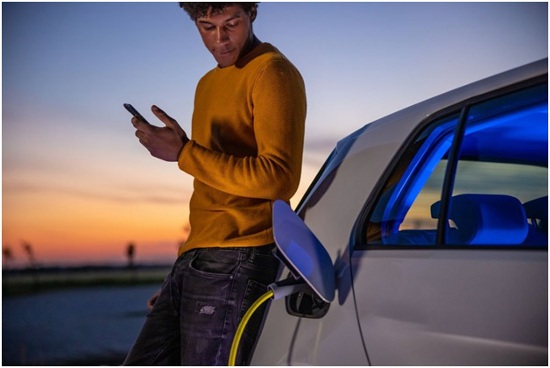The development of electric vehicles, or EVs, has been just recent. But at the same time, they have gained a rapid surge in popularity. The first EVs were developed as a response to the high price of gasoline and the environmental impact of burning fossil fuels.

In modern times, EVs have come to the forefront of the automotive industry as an environmentally friendly and cost-effective alternative to traditional internal combustion engine (ICE) vehicles. With the rise of EVs, many people are curious about what they are and how they operate.
Despite their growing proliferation, there are still myths about these EVs that should be dispelled. Let’s take a look at them, and see the real score.
5 Common Myths About Electric Vehicles
Despite their increasing presence on the roads, many potentially outdated and inaccurate myths and misconceptions about EVs exist. These myths can range from the practical—such as charging times and range—to the environmental—such as emissions and recycling.

Myth 1: Electric Vehicles Are Worse For The Climate Than Gas-Operated Vehicles
Fact: Electric vehicles have become increasingly popular, with a growing number of drivers taking advantage of their environmental benefits. However, many people still express doubts about the environmental impact of electric cars, suggesting that they may actually be worse for the environment than gasoline cars. But is this really the case?
Electric vehicles don’t have emissions on their tailpipe. But the process of generating electricity through their batteries may cause carbon pollution. In the grand scheme of things, the carbon emission generated by electric vehicles doesn’t contribute that much to the proliferation of greenhouse gases than even the newest gasoline vehicle.
Electric vehicles run on battery packs made by lithium battery manufacturers. These are environmentally safe battery packs for your EVs.
Myth 2: The Battery Packs Used In Electric Vehicles Cause Pollution
Fact: Electric vehicles have become increasingly popular over the last few years as a way to reduce environmental impact- but is it all it’s cracked up to be?
Even though electric vehicles have the potential to significantly reduce carbon dioxide emissions, many people are quick to point to battery packs and argue that electric cars still cause pollution. This myth has seen traction, and it can be challenging to find an alternative viewpoint.
A number of studies indicate that manufacturing a standard electric vehicle can cause more pollution than manufacturing a gas-powered car. Of course, there’s merit to this, considering that the process of creating EV batteries requires more energy. SunlyPower and other EV battery pack manufacturers ensure that their production has minimal environmental impact.
However, we should see things in the long-term. Throughout the lifetime of these electric vehicles, their total greenhouse gas emission remains lower than the greenhouse gas generated by gas-operated vehicles.
Again, the reason for this is due to the absence of tailpipe emissions in these electric vehicles. In fact, there’s a stark difference between the emissions of these two types of vehicles, proving the fact that these EVs are the more environmentally-friendly transport mediums.
Furthermore, you can recycle these EV batteries, which minimizes the need to create more batteries. EV batteries are some of the most important components of EVs, and being able to recycle them is essential for reducing the amount of waste that goes into landfills and for improving the environment.
Myth 3: There’s Nowhere To Charge An Electric Vehicle
Fact: Electric cars have been increasing in popularity over the past decade, and questions about their practicality often arise. One of the most common questions is whether electric vehicles have enough places to charge. This question is understandable, as no one wants to be stranded with a dead car. However, this is a myth – there are plenty of places where you can charge your electric vehicle.
The best thing about these electric vehicles is that you can charge them the way you charge your electronics and devices. Specifically, they can be charged using the standard 120-volt outlet. If you want to charge them faster, install a 240-volt charging outlet instead. Don’t worry if you leave your home, though. In the United States alone, there are more than 45,000 charging stations for these electric vehicles. At the same time, these stations are open to the public.
Admittedly, not all countries have a proliferation of these charging stations. But given that you can charge them using conventional means, the problem of charging is becoming non-existent.
Myth 4: They Don’t Run Far
Fact: For decades, electric vehicles (EVs) have been touted as the eco-friendly solution to reduce fossil fuel dependence, but one of the biggest myths has been that they don’t travel far. With advances in technology, EVs can travel long distances, making them an ideal option for those who want to reduce their environmental footprint without sacrificing comfort, convenience, or fuel efficiency.
Modern electric vehicles are already capable of covering a common daily travel distance of a household. Specifically, this should be around 50 miles per day, which is not short! Average households in the United States have a travel distance of fewer than 100 miles every day.
Keep in mind that high-end electric vehicles can cover up to 200 miles if they are fully charged. Meanwhile, the standard ones can run up to 100 miles when fully charged.
Of course, the actual distance varies depending on several factors, such as the driving conditions, the way you drive, and the external temperatures. For instance, driving under the heat of the sun could reduce the fuel economy of vehicles by as high as 40 percent.
Myth 5: Electric Vehicles Are Only Sedans
Fact: Electric vehicles (EVs) can be a great alternative to traditional gas-powered cars for those looking for an environmentally friendly transportation option. Unfortunately, there is a popular misconception that EVs only come in the form of sedans.
This assumption fails to recognize the wide variety of EV models that have been developed in recent years. From SUVs to minivans to compacts and hatchbacks, EVs are available in a variety of shapes and sizes, allowing them to become the perfect vehicles for any lifestyle. Sooner or later, the variation of these electric vehicles would expand. And that means that you have a plethora of options to choose from.
Final Thoughts
As mentioned, these electric cars are becoming a more environmentally friendly and cost-effective means of transportation. However, they are still relatively new and untested technology, so there are many misconceptions and myths circulating about their capability and potential. With the explanations, we listed here, we hope that all the qualms and uncertainties you have when it comes to these EVs are already dispelled.
